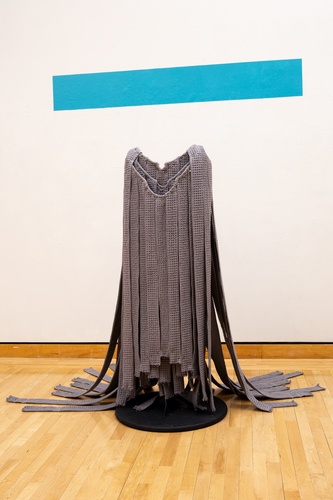Emily Fruth
Emily Fruth
Description of Work
Distress Signals: Dissociation Cloak - 60" x 22" x 48" - Brass, cotton fabric, quilt batting, thread, vinyl tubing, lead weights - NFS
Artist's Statement
When I was in my late teens, I spent two and a half years in a sexually abusive relationship. Because of the inherently physical nature of this experience, many of the triggers that activate my trauma responses are also very physical. Many of the stimuli associated with the touch of another person cause my brain to automatically shut itself off from emotion and sensation. This state is called dissociation. Dissociation is a form of distress that is invisible to others unless verbally communicated, which is excruciatingly difficult to accomplish.
Distress Signals: Dissociation Cloak is a tactile, experiential object that creates my dissociative symptoms in ways that are externally observable. It creates around the wearer a cushioned, monochromatic micro-environment in which one is both insulated and isolated. The thick quilt batting and heavily textured fabric dull physical sensations, and with them the emotions connected to them. The cloak shields the wearer from incidental touch, while impairing the ability to protect oneself from insistent, intentional touch in the areas it leaves vulnerable. This interferes with the wearer’s ability to connect with other people, yet is remarkably ineffective protection from further trauma. The glittering necklace of safety pins around the cloak’s upper edge symbolically draws a hard line where protection ends and exposure begins, highlighting the disconnect between the object’s intent and its impact. The lead pieces sewn into the fabric strips add weight to the wearer’s body, cause every action to require a little more deliberation and energy to complete, and impede movement, diminishing overall functionality.
This work is not about what happened to me. It is about how I experience life differently now. It is not about the past, but about the present. The present is the part of my ordeal that is relevant to the people around me. I am sharing this with you because in this relationship, I am a survivor, and you are my supporter. As my supporter, it is important for you to know how to support me. Questions about the present (i.e. “how are you feeling?” “are you safe?” “what do you need?” and “can I help?”) are relevant to our relationship, and are likely to make me feel cared for and supported. Questions about the past (i.e. “what happened?” “did you press charges?” and “why didn’t you just leave?”) are not relevant to our relationship, and are likely to make me feel retraumatized, judged, and blamed. Bear this in mind going forward, and from it form a better understanding of how to be a force of healing for other survivors rather than a source of pain.
If you wish to purchase any of these pieces, please contact the gallery director, Jacqueline Nathan (jnathan@bgsu.edu.)


Updated: 04/20/2020 02:56PM




